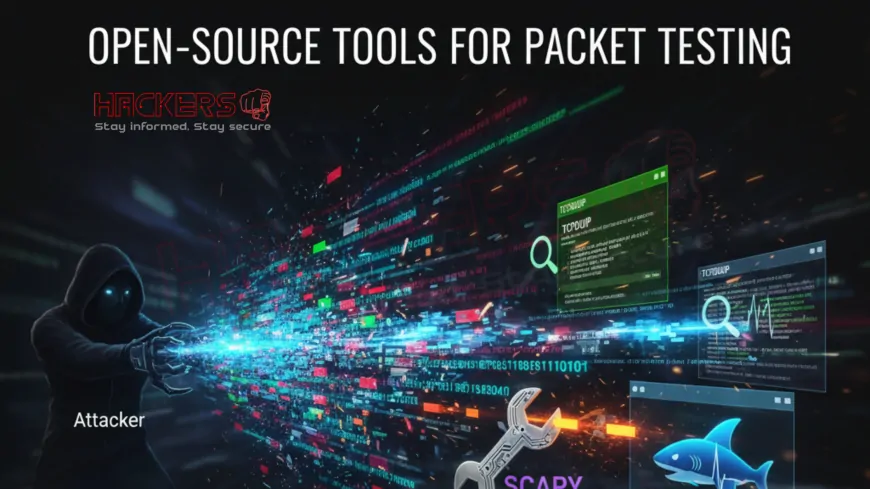What Are the Most Useful Open-Source Tools for Packet Crafting and Analysis?
In the world of cybersecurity and network management, understanding network traffic is like reading the pulse of your digital infrastructure. Packet crafting and analysis allow you to create, send, and inspect data packets to test network security, diagnose issues, or simulate attacks responsibly. Open-source tools make these tasks accessible to everyone, from beginners to seasoned professionals, without the hefty price tag of commercial software. This blog post explores the most useful open-source tools for packet crafting and analysis, explaining how they work and when to use them. Written in a clear, beginner-friendly tone, this guide will help you navigate these powerful tools to strengthen your network’s defenses.

Table of Contents
- What Is Packet Crafting and Analysis?
- Why Use Open-Source Tools?
- Top Open-Source Tools for Packet Crafting and Analysis
- Comparison of Packet Crafting and Analysis Tools
- How to Use These Tools Effectively
- Common Use Cases
- Best Practices for Safe and Ethical Use
- Conclusion
- Frequently Asked Questions
What Is Packet Crafting and Analysis?
Packets are small chunks of data that travel across networks, carrying information like web requests or email messages. Packet crafting and analysis involve creating custom packets or inspecting existing ones to understand or manipulate network behavior.
- Packet Crafting: Building and sending custom data packets to test network responses, simulate attacks, or bypass restrictions. It’s like writing a custom letter and mailing it to see how the recipient reacts.
- Packet Analysis: Examining packets to understand network traffic, diagnose issues, or detect malicious activity. It’s like reading the letters others are sending to spot problems or threats.
These processes are critical for cybersecurity testing, network troubleshooting, and ensuring robust defenses, but they must be used ethically and legally.
Why Use Open-Source Tools?
Open-source tools are free, community-driven software that anyone can use, modify, or contribute to. They’re ideal for packet crafting and analysis because:
- Cost-Free: No licensing fees, making them accessible to students, hobbyists, and professionals.
- Customizable: Open source code allows you to tweak tools for specific needs.
- Community Support: Large communities provide tutorials, forums, and updates.
- Transparency: Open code ensures no hidden backdoors or malicious features.
However, these tools require responsible use, as they can be misused to harm networks if not handled carefully.
Top Open-Source Tools for Packet Crafting and Analysis
Several open-source tools stand out for their power and versatility in packet crafting and analysis. Here are the most popular ones:
- Wireshark: The go-to tool for packet analysis, Wireshark captures and displays network packets in a user-friendly interface, with powerful filtering options.
- Scapy: A Python-based tool for crafting and analyzing packets, offering unmatched flexibility for creating custom packets.
- hping3: A command-line tool for crafting TCP/IP packets, often used for testing firewalls or simulating attacks like SYN floods.
- tcpdump: A lightweight packet capture tool that records network traffic for analysis, ideal for quick diagnostics.
- Nmap: While primarily a network scanning tool, Nmap can craft packets to probe network devices and analyze responses.
Each tool has unique strengths, making them suitable for different tasks in network testing and security.
Comparison of Packet Crafting and Analysis Tools
Choosing the right tool depends on your goals. Here’s a comparison of the top tools:
| Tool | Primary Function | Ease of Use | Best For |
|---|---|---|---|
| Wireshark | Packet analysis | Easy, GUI-based | Traffic monitoring, diagnostics |
| Scapy | Packet crafting and analysis | Moderate, requires Python | Custom packet creation |
| hping3 | Packet crafting | Moderate, command-line | Firewall testing, attack simulation |
| tcpdump | Packet capture | Moderate, command-line | Quick traffic capture |
| Nmap | Packet crafting and scanning | Easy to moderate | Network discovery, port scanning |
How to Use These Tools Effectively
Here’s a beginner-friendly guide to using these tools for packet crafting and analysis:
Wireshark
- Install: Download from wireshark.org and install on Windows, macOS, or Linux.
- Capture Traffic: Select a network interface (e.g., Wi-Fi) and start capturing packets.
- Filter Data: Use filters like
ip.addr == 192.168.1.1to focus on specific traffic. - Analyze: Inspect packet details, like HTTP requests or TCP flags, to diagnose issues.
Scapy
- Install: Install Python and Scapy via
pip install scapy. - Craft Packets: Write a Python script, e.g.,
send(IP(dst="192.168.1.1")/TCP(dport=80)), to send a TCP packet. - Analyze: Use
sniff(filter="tcp")to capture and inspect TCP packets.
hping3
- Install: Install via
sudo apt install hping3on Linux. - Craft Packets: Run
hping3 --syn --flood 192.168.1.1 -p 80to simulate a SYN flood. - Analyze Responses: Check server responses to identify firewall rules or vulnerabilities.
tcpdump
- Install: Available on most Linux systems or install via
sudo apt install tcpdump. - Capture Traffic: Run
tcpdump -i eth0 -w capture.pcapto save traffic to a file. - Analyze: Open the file in Wireshark or use
tcpdump -r capture.pcapto read it.
Nmap
- Install: Download from nmap.org or install via
sudo apt install nmap. - Scan Network: Run
nmap -sS 192.168.1.0/24to perform a SYN scan. - Analyze Responses: Review open ports and services to map network devices.
Always test these tools in a controlled environment with permission to avoid legal issues.
Common Use Cases
These tools have practical applications in various scenarios:
- Network Troubleshooting: Use Wireshark or tcpdump to diagnose slow connections or dropped packets.
- Security Testing: Craft packets with Scapy or hping3 to test firewall rules or simulate attacks like DDoS.
- Vulnerability Scanning: Use Nmap to identify open ports or outdated services on a network.
- Attack Analysis: Analyze captured packets to identify malicious traffic, like botnet activity.
- Performance Optimization: Monitor traffic patterns to optimize network configurations.
These use cases make the tools invaluable for both defensive and diagnostic tasks.
Best Practices for Safe and Ethical Use
Packet crafting and analysis tools are powerful but must be used responsibly:
- Obtain Permission: Always get explicit consent before testing networks or systems you don’t own.
- Use Isolated Environments: Test in a lab or virtual network to avoid disrupting live systems.
- Stay Legal: Comply with laws like the U.S. Computer Fraud and Abuse Act to avoid legal trouble.
- Secure Tools: Keep tools updated to avoid vulnerabilities and verify downloads from official sources.
- Document Tests: Record test plans, permissions, and results for transparency and compliance.
Conclusion
Open-source tools like Wireshark, Scapy, hping3, tcpdump, and Nmap are game-changers for packet crafting and analysis, offering powerful capabilities for free. Whether you’re troubleshooting a slow network, testing security, or analyzing attacks, these tools provide the flexibility and insight needed to get the job done. By using them ethically and following best practices, you can strengthen your network’s defenses and stay ahead of cyber threats. Start exploring these tools today, and take control of your network’s security and performance.
Frequently Asked Questions
What is packet crafting?
It’s creating and sending custom data packets to test or manipulate network behavior.
What is packet analysis?
It’s examining network packets to diagnose issues, monitor traffic, or detect threats.
Why use open-source tools?
They’re free, customizable, transparent, and supported by active communities.
Is Wireshark good for beginners?
Yes, its graphical interface and filters make it easy to learn and use.
What can Scapy do?
Scapy crafts and analyzes packets, allowing custom packet creation via Python scripts.
Is hping3 only for attacks?
No, it’s used for testing firewalls, network performance, and simulating attacks responsibly.
How does tcpdump differ from Wireshark?
tcpdump is a lightweight, command-line tool for capturing packets, while Wireshark offers a GUI and detailed analysis.
Can Nmap craft packets?
Yes, Nmap crafts packets for scanning and probing network devices.
Is it legal to use these tools?
Yes, with permission and in controlled environments, but unauthorized use can violate laws.
What is a SYN flood?
It’s an attack where fake TCP connection requests overwhelm a server, testable with hping3.
Can I use these tools on any network?
Only on networks you own or have explicit permission to test, to avoid legal issues.
How do I filter packets in Wireshark?
Use filters like ip.addr == 192.168.1.1 to focus on specific traffic.
Do I need coding skills for Scapy?
Basic Python knowledge is required to craft and analyze packets effectively.
Can tcpdump save captures?
Yes, use tcpdump -w file.pcap to save captures for later analysis.
What is a packet filter?
It’s a rule to select specific packets, like those from a certain IP or protocol, for analysis.
Can these tools detect malware?
Yes, by analyzing traffic patterns for suspicious activity, like botnet communications.
How do I install Wireshark?
Download it from wireshark.org and follow the installation instructions for your OS.
Can I use these tools on Windows?
Yes, Wireshark, Scapy, and Nmap support Windows; hping3 and tcpdump are Linux-focused but work via WSL.
What is a controlled environment?
It’s an isolated network, like a virtual lab, for safe testing without affecting live systems.
How do I learn these tools?
Start with tutorials on official websites, YouTube, or cybersecurity courses like CEH.
What's Your Reaction?































































